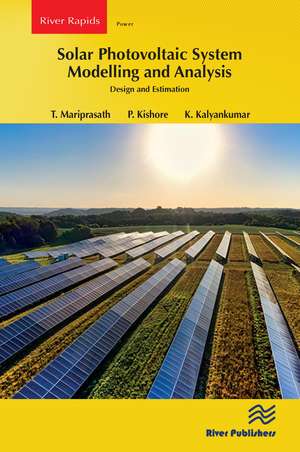Solar Photovoltaic System Modelling and Analysis: Design and Estimation: River Publishers Series in Power
Autor T. Mariprasath, P. Kishore, K. Kalyankumaren Limba Engleză Paperback – 4 mar 2024
Solar Photovoltaic System Modelling and Analysis covers topics such as:
- Relevance, types, and growth rate of renewable resources
- How solar PV systems generate electricity
- Panel varieties and their importance
- Solar PV designs and architectures
- Charge controllers, including the latest technologies
- Boost converter modelling and analysis in MATLAB
- The necessity of hybrid power plants (modelling and analysis)
- Designing a solar PV system including panel selection for a specific application, as well as converter and inverter estimation
Preț: 387.93 lei
Preț vechi: 421.67 lei
-8% Nou
Puncte Express: 582
Preț estimativ în valută:
74.23€ • 77.50$ • 61.43£
74.23€ • 77.50$ • 61.43£
Carte tipărită la comandă
Livrare economică 05-19 aprilie
Preluare comenzi: 021 569.72.76
Specificații
ISBN-13: 9788770040907
ISBN-10: 8770040907
Pagini: 102
Ilustrații: 38
Dimensiuni: 156 x 234 x 12 mm
Greutate: 0.19 kg
Ediția:1
Editura: River Publishers
Colecția River Publishers
Seria River Publishers Series in Power
ISBN-10: 8770040907
Pagini: 102
Ilustrații: 38
Dimensiuni: 156 x 234 x 12 mm
Greutate: 0.19 kg
Ediția:1
Editura: River Publishers
Colecția River Publishers
Seria River Publishers Series in Power
Public țintă
Postgraduate and Professional Practice & DevelopmentNotă biografică
Dr. T. Mariprasath (first author) received his Ph.D. degree from the Rural Energy Centre, The Gandhigram Rural Institute (Deemed to be University), in January 2017, fully funded by the Ministry of Human Resource Development—Government of India. He has been working as an Associate Professor with the Department of EEE, K.S.R.M. College of Engineering (Autonomous), Kadapa, since June 2018. He has published in 10 science citation indexed journals and 15 Scopus indexed articles. Moreover, he has published a book with Cambridge Scholars Publishing, UK. He also has an Indian patent granted. His research interests include renewable energy engineering, renewable energy resources, micro grid, green dielectrics, and artificial intelligence.
Dr. P. Kishore received his Ph.D. in Physics with Photonics Specialization from National Institute of Technology in 2015. He completed his M.Sc. Physics (Electronics) and B.Sc. (M.P.Cs.) from the Sri Venkateswara University Tirupati. He has eight years of teaching experience in physics and photonics subjects. He has published 70 research articles in reputed journals and conference proceedings. He has also published four book chapters and filed one Indian IPR patent. Currently he is working as an Assistant Professor of Physics in the department of Sciences at Indian Institute of Information Technology Desing and Manufacturing Kurnool, Andhra Pradesh India. He works in the areas of optics, photonics, renewable energies and allied areas.
Mr. K. Kalyankumar is pursuing a Ph.D at Yogi Vemana University, Andhrap Pradesh, India, He has been working as an Assistant Professor with the Department of EEE, K.S.R.M. College of Engineering (Autonomous), Kadapa, since December 2006. He has published five Scopus indexed articles and four book chapters. His research interests include power systems, electrical machines and power electronics.
Dr. P. Kishore received his Ph.D. in Physics with Photonics Specialization from National Institute of Technology in 2015. He completed his M.Sc. Physics (Electronics) and B.Sc. (M.P.Cs.) from the Sri Venkateswara University Tirupati. He has eight years of teaching experience in physics and photonics subjects. He has published 70 research articles in reputed journals and conference proceedings. He has also published four book chapters and filed one Indian IPR patent. Currently he is working as an Assistant Professor of Physics in the department of Sciences at Indian Institute of Information Technology Desing and Manufacturing Kurnool, Andhra Pradesh India. He works in the areas of optics, photonics, renewable energies and allied areas.
Mr. K. Kalyankumar is pursuing a Ph.D at Yogi Vemana University, Andhrap Pradesh, India, He has been working as an Assistant Professor with the Department of EEE, K.S.R.M. College of Engineering (Autonomous), Kadapa, since December 2006. He has published five Scopus indexed articles and four book chapters. His research interests include power systems, electrical machines and power electronics.
Cuprins
1. Renewable Energy 2. Photovoltaic Systems 3. Types of Solar Photovoltaic Systems 4. Solar Charge Controller 5. Necessity of Boost Converters 6. Necessity of a Hybrid Power Plant 7. Domestic Application
Descriere
This book outlines the global opportunity to increase solar photovoltaic (PV) plant energy yields through modelling and analysis.




